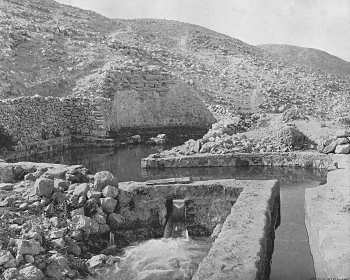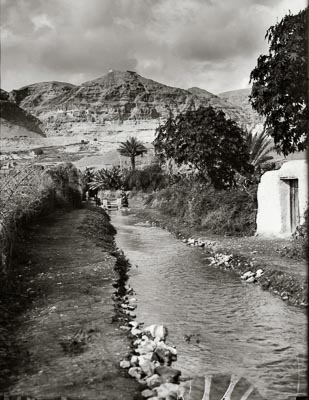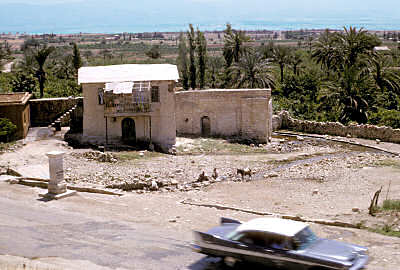
Jericho, Elisha's Spring
Ain-es-Sultan, The Sultan's Spring
When we leave the upper channel of the river not a tree or blade of grass, only a few shrubs with microscopic foliage, are visible till we reach the oasis of old Jericho, Ain-es-Sultân . . . . We halt in front of the famous spring, the Prophet's Fountain, Ain-es-Sultân . . . shaded by a fine fig-tree, where an immense volume of clear warm water, 84° Fahr., very pure, and swarming with fish, bursts from the shingle at the foot of a great mound, evidently artificial, and composed of the remains of ancient Jericho, full of fragments of pottery and frequent morsels of nacreous glass. Behind the spring, and partially enclosing it, is a ruined edifice, apparently a small Roman temple; and strewn about are fragments of shafts and Byzantine capitals. The copious stream is tapped within fifty yards of its exit by various artificial watercourses, through which the Arabs lead the life-giving liquid from time to time over their patches of cultivation, through jungles of cane and tamarisk. (Source: Picturesque Palestine, vol. 1, pp. 170-171.)
Elisha's Fountain

Source: Earthly Footsteps of the Man of Galilee, p. 152.
Ain es-Sultan, Elisha's Spring, by which Jericho was once supplied with water, still exists and wells forth copiously from the earth. It flows into a pond or reservoir. The temperature is eighty degrees Fahrenheit. Near it stand two mills in a state of dilapidation. The fountain is shaded by a large fig tree. Enough water flows from this spring to irrigate the whole plain of Judea. This is supposed to be Elisha's Spring, referred to in II Kings, chapter ii, 19-22--the waters which Elisha healed. The land around the spring now belongs to the Sultan of Turkey. His agents had the land sown in wheat in this neighborhood, which was ripe when we passed through it in April. (Source: Earthly Footsteps of the Man of Galilee, p. 152.)
Elisha's Fountain
Between this fountain and the modern Jericho the Russians have secured three or four acres of land, where they have a convent and a school. They irrigate the soil with the water from Elisha's Spring, and the wealth of vegetation seen on these premises gives us some idea of what the land was in the days when it was all cultivated and watered. The remains of a paved Roman road have been found in the vicinity. The site of the house of Rahab was shown as being a short distance above the spring, and it is supposed that the ancient town must have stood at this spot. (Source: Earthly Footsteps of the Man of Galilee, p. 152.)
See Jericho, Jordan River, Entering the Promised Land, Jordan River Baptisms, Good Samaritan, or Dead Sea
At BiblePlaces, see Jericho

